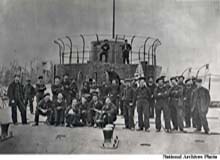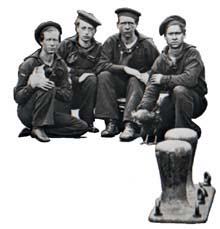
Some of the enlisted crew on the monitor USS Lehigh pose on deck of their ironclad. The boredom of blockade duty on the James River in Virginia was broken by a photographer's party that recorded several images of monitors on the James. These men thought enough of their ship's mascots to include them in this group photo. One sailor (left of center) holds the ship's cat while the sailor in the center holds a fighting cock. Click image for a larger view. (National Archives photo).
A Cat in the Cannon?
Jeff Johnston
Program Specialist
Monitor National Marine Sanctuary
“A black cat was sitting on the breech of one of the guns, howling one of those hoarse and solemn tunes which no one can appreciate who is not filled with the superstitions which I had been taught by the sailors, who are always afraid to kill a cat. I would almost as soon have touched a ghost, but I caught her, and placing her in another gun, replaced the wad and tampion; but I could still hear that distressing yowl.”
This single paragraph has generated one of the most frequently asked questions about the USS Monitor: “Is there a cat in one of the Monitor’s cannon barrels?”
Francis B. Butts came on board the Monitor just before she left the Washington Navy Yard in November 1862. A native of Rhode Island, Butts eventually wrote about his brief stint aboard the Monitor for a presentation to the Rhode Island Soldiers and Sailors Society. Excerpts of his “dramatic first-person story” were later printed in Century Magazine in 1885. In his account he states, “I occupied the turret all alone….” Francis Butts, it seems, is also the lone person who remembered an ironclad kitty.
A Ship's Mascot
A mascot on a warship used to be fairly common, and the era of the American Civil War was no exception. Dozens of surviving photographs show officers or crew proudly posing on the decks of their warships with a loyal dog lying in the front, or a cat crooked in a sailor’s arm. There is even a photograph of the crew of the monitor USS Lehigh posing on deck with one seaman holding a cat while another seaman off to his left holds a fighting cock. A letter home from a sailor on board the monitor USS Weehawken boasts of their ship’s fighting cock "taking station" on top of the ship’s pilot house when the vessel went into action off Charleston. Union newspapers carried tales of brave mascots following their regiments into battle. Stories of dogs that followed their regiments into battle and guarded over the fallen dead of their masters were a fairly common theme in the Northern press.
So it seems likely that if the USS Monitor had a mascot on board, someone other than Mr. Butts would have noticed. This cat had the potential to be the most famous cat in the Union.
The Monitor’s Paymaster, William Keeler, was on board the ship for the duration of her short life. He wrote letters home to his wife Anna on a regular basis, detailing all aspects of his life aboard the Monitor, and his letters carry an impressive amount of detail. But William Keeler never mentions a ship’s cat.

Detail of the four crewmen of the monitor USS Lehigh. The sailor at the left cradles the ship's cat to his chest, while the sailor at the far right steadies a fighting cock for the camera. Click image for a larger view. (National Archives photo).
A few years ago, a family donated an impressive collection of letters to The Mariners’ Museum that were written by George Geer, one of the enlisted men of the Monitor. Geer served as a fireman and sailed with the Monitor from beginning to end. He also wrote to his wife on a fairly regular basis. While his letters do not contain the minute details of some of Keeler’s, Mr. Geer does provide us with a view of an enlisted man’s life on the famous ship. He does not mention a cat either.
If the Monitor had a mascot, it most likely wasn’t on board during the engagement in Hampton Roads. What journalist would have passed up that story? When the Monitor was sent to the Washington Navy Yard in October 1862 for repairs, the ship received a heroic welcome. Her decks were open to the public and visitors thronged to visit the ironclad. Yet again, no one mentions a cat.
Just before the ship left the Washington Navy Yard for Hampton Roads, Francis Butts was one of seven men who signed aboard to make up deficiencies in the crew numbers. It is possible that before the ship left, one of her crew adopted a “yard cat.
Captain John P. Bankhead received orders to prepare his vessel for a trip south on Christmas day 1862. With all the flurry of activity that must have accompanied that order, one of the Monitor’s crew may have adopted one of the wayward felines that, even today, live along the local Virginia docks. It is possible, but not documented.
A Cat Owner's Perspective
That covers the historical facts, but what about the practical facts? As the proud owner of four cats, I can believe that the act of placing a scared, wet, and agitated cat into the 11-inch opening of a Dahlgren cannon for its protection would certainly have been a noble act. It also most certainly could have provided a bit of comic relief in a very serious situation. In fact, I think of Francis Butts every time I try to place one particular black cat into the kitty carrier with a 15-inch opening just before a routine trip to the vet.
If the weather off Cape Hatteras is kind to us during the 2002 Monitor Expedition, we might soon know the answer to the question of the cat. Once the Monitor’s gun turret and cannons are recovered, we hope that radiography will solve this feline mystery once and for all.
Sign up for the Ocean Explorer E-mail Update List.

































